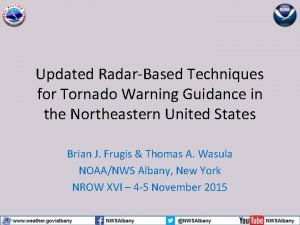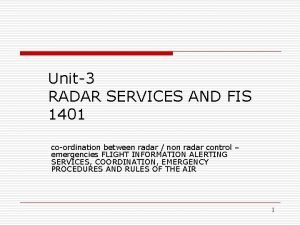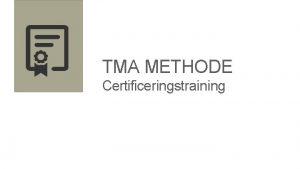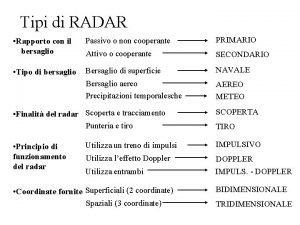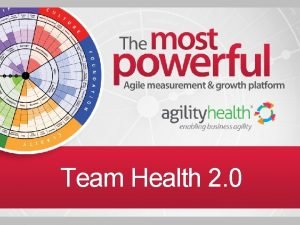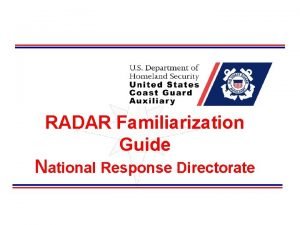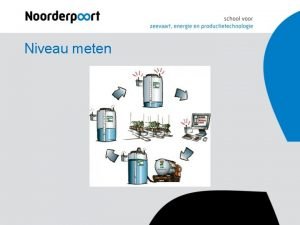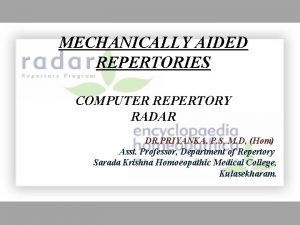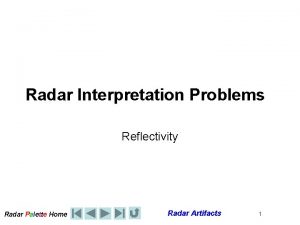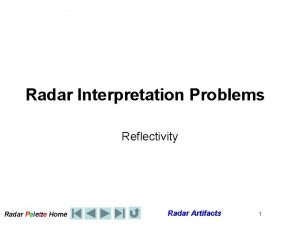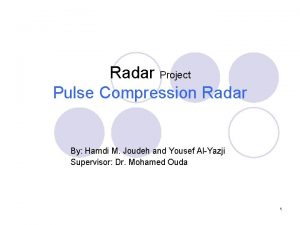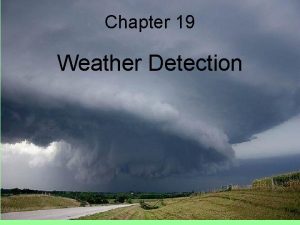What is Project RADAR Project RADAR is an









































- Slides: 41


What is Project RADAR? Project RADAR is an initiative of VDH’s Office of Family Health Services that was developed to enable health care providers to effectively recognize and respond to intimate partner violence (IPV) by providing: Ø“Best Practice” Policies, Guidelines, and Assessment Tools ØTraining Programs and Specialty-Specific Curricula ØAwareness and Educational Materials ØCurrent Research Findings on Intimate Partner

Training Objectives By the end of this training, participants will be able to: ü Define intimate partner violence (IPV) ü Perform specific screening, assessment, and intervention strategies ü Identify and formulate responses to challenges specific to the health care setting ü Direct victims of IPV to appropriate resources ü Train providers using the RADAR curricula

What is IPV? Intimate Partner Violence (IPV) is a pattern of assaultive and coercive behaviors that may include inflicted physical injury, psychological abuse, sexual assault, progressive social isolation, stalking, deprivation, intimidation, and threats. These behaviors are perpetrated by someone who is, was, or wishes to be involved in an intimate or dating relationship with an adult or adolescent, and are aimed at establishing control by one partner over another.

Who Are Victims and Batterers? VICTIMS: BATTERERS: • Women and men • Adolescents, teens, young, middle-aged and older adults • People of all cultures and religions • Blue collar, middle class, and wealthy • Straight, gay, lesbian, and transgender • Married and unmarried • People with and without high school or college degrees

The Dynamics of Abuse: The Power & Control Wheel • In the early 80’s in Duluth, Minnesota, victims of IPV attending educational groups were interviewed about the behaviors of their abusers and factors that influenced why they stayed in violent relationships/returned to their abusers. • Based on input from over 200 battered women, they developed a framework for understanding IPV. • Key finding, as conceptualized in the “power and control wheel” is that abusers use an array of tactics--apart from physical and sexual violence--to gain and maintain control over their victims.

Making and/or carrying out threats to do something to hurt her Threatening to leave her, to commit suicide, to report her to welfare Making her drop charges Making her do illegal things Preventing her from getting or keeping a job Making her ask for money Giving her an allowance Taking her money Not letting her know about or have access to family income Treating her like a servant Making all the big decisions Acting like the “master of the castle” Being the one to define men’s and women’s roles Making her feel guilty about the children Using the children to rely messages Using visitation to harass her Threatening to take the children away Making her afraid by using looks, actions, gestures Smashing things Destroying her property Abusing pets Displaying weapons Using Coercion Intimidation & Threats Using Economic Abuse Using Male Privilege Using Emotional Abuse Using Isolation Using Minimizing, Children Denying & Blaming Putting her down Making her feel bad about herself Calling her names Making her think she’s crazy Playing mind games Humiliating her Making her feel guilty Controlling what she does, who she sees and talks to, what she reads, where she goes Limiting her outside involvement Using jealousy to justify actions Making light of the abuse, and not taking her concerns about it seriously Saying the abuse didn’t happen Shifting responsibility for the abusive behavior Saying she caused it

Factors that Influence Victims • • Loss of status $$$ Good times Family Religion Kids Culture FEAR **Intimate partner violence occurs within the context of the victim’s life.

IPV as a Critical Public Health Issue • More than 25% of women are abused by a partner at some point in their lives. • Based on data from 1995, the CDC concluded that IPV costs the U. S. $4. 1 billion each year in direct medical costs and another $1. 8 billion in indirect costs (lost productivity, etc). Extrapolated to 2003, these costs were estimated at $8. 3 billion. • Mental health care costs are estimated to be 800% higher for abused versus non abused women. • In addition to injuries sustained by victims during violent episodes, abuse is linked to: --Arthritis --Chronic neck, back, & --Migraines pelvic pain --Gastrointestinal problems --STI’s --Pregnancy Complications --Substance abuse

The Impact of IPV on its Victims Adults • Physical injuries • Chronic physical ailments related to injuries and stress • Mental health problems including depression, anxiety, and PTSD • Social consequences caused by loss of contact with family, friends, work, and children • Financial strain due to: loss of income and denial of education and/or career advancement • Spiritual effects such as loss of faith and alienation from Children • Developmental delays • Mental health issues including depression, anxiety, PTSD, ODD, and sleep disorders • Behavior disorders • Poor adaptive and social skills • Increased risk for substance abuse, suicide, and criminal behavior as teens and adults • Elevated likelihood for perpetrating abuse as teens and adults • Increased vulnerability to victimization as teens and adults

Intimate Partner Homicide: Paying the Ultimate Price In Virginia: Ø Nearly one in three homicides is related to family or intimate partner violence. Ø Over half of all adult female homicide victims are killed by intimate partners.

Case Studies of the Impact of IPV in Virginia Case #1: • 53 year old female • Suspect boyfriend • Multiple Injuries – Attempted strangulation – Dental

Case Studies of the Impact of IPV in Virginia • Contusions to the neck from attempted strangulation • Different stages of healing, indicating old & recent injuries

Case Studies of the Impact of IPV in Virginia Case #2: • Manual Strangulation • Self-inflicted defensive wounds

Case Studies of the Impact of IPV in Virginia Case #3: • Human bite marks • Very common on upper body in cases of domestic violence

Case Studies of the Impact of IPV in Virginia Case #4: • Male Victim • Assaulted w/ Baseball Bat • Readmitted to hospital a year later for stab wounds to chest and nearly died of heart failure.

IPV is an Issue for ALL Health Care Providers. • Victims report that they are not embarrassed to be asked about abuse and that discussing it would strengthen relationships with health care providers. • Victims feel that providers can help. • Joint Commission and professional standards • Providers have a unique opportunity to identify victims and provide critical interventions and referrals. – 44 -47% of women killed by their intimate partners have been seen by a health care provider in the year prior to their deaths.

Joint Commission Standards Relevant to IPV Policy and Practice In 2004, The Joint Commission instituted new standards for hospitals on how to respond to domestic abuse, neglect and exploitation and revised them in 2009. • • RI. 2. 150—Patients have the right to be free from mental, physical, sexual, and verbal abuse, neglect, and exploitation. 1 RI. 2. 170—Patients have the right to access protective and advocacy services. RI. 3. 10—Criteria for identifying and assessing victims of abuse, neglect, or exploitation should be used throughout the hospital. EC. 2. 10—The hospital identifies and manages its security risks

Joint Commission Standards Relevant to IPV Policy and Practice Elements of Performance: • The organization addresses how it will, to the best of its ability, protect patients from real or perceived abuse, neglect [including involuntary seclusion for Long Term Care], or exploitation from anyone, including staff, students, volunteers, other [patients/residents/clients], visitors, or family members. • All allegations, observations, or suspected cases of abuse, neglect, or exploitation that occur [in the organization for all except OME] are investigated by the organization.

Professional Standards The American Medical Association’s Guidelines for Detecting and Treating Family Violence state 1: “Physicians should routinely inquire about physical, sexual, and psychological abuse as part of the medical history. Physicians must also consider abuse in the differential diagnosis for a number of medical complaints, particularly when treating women…[and] have an obligation to familiarize themselves with protocols for diagnosing and treating abuse and with community resources for battered women, children, and elderly persons… Physicians must be better trained to identify signs of abuse and to work cooperatively with the range of community services…Comprehensive training on family violence should be required in medical school curricula and in residency programs for specialties in which family violence 1 E-2. 02 Abuse of Spouses, Children, Elderly Persons, and Others at Risk is likely to be encountered. ”

How Are We Doing in Virginia? The 2009 Intimate Partner Violence Health Care Provider Survey Methodology • Designed to assess knowledge attitudes and behaviors of Virginia’s health care providers concerning IPV • Sent to dentists, hygienists, licensed clinical social workers, psychiatrists and medical doctors who self -identified a specialty area of family/general practice, obstetrics/gynecology, pediatrics or emergency. Other settings included were: community health centers, free clinics, family planning clinics at local health departments, and campus health centers. • Of 10, 325 surveys mailed, a total of 4, 481 were

How Are We Doing in Virginia? The 2009 Intimate Partner Violence Health Care Provider Survey Results • 85. 4 % of providers have never attended an IPV training/workshop. • Even though over 1 in 3 providers indicated that either they or someone close to them had been a victim of IPV, half reported that they do not use screening questions with any patients. • Even when the patient presented with a bruise or laceration, only 1 in 4 providers consistently (“always” or “almost always”) asked about the possibility of IPV. • Over 2/3 (67%) of providers reported that, to their knowledge, their workplace does not have any written guidelines regarding IPV.

The Hospital Policy Analysis Project Characteristics of Participating Hospitals • 62 hospitals participated (RR=76. 5%) • Distributed across the five health planning districts • Equally distributed in terms of bed size and average number of ED visits annually • 67% of study hospitals in a health system, compared to 61% of all Virginia hospitals • Type of ownership (public, private, government) of study hospitals representative of ownership distribution of all Virginia hospitals.

The Hospital Policy Analysis Project Key Findings • Only 24. 6% of participating hospitals had a ‘stand-alone’ policy on IPV. • 36. 1% did not provide any definition of IPV or DV anywhere in the policy. • Only 2. 4% referenced JCAHO standards on abuse. • Reporting requirements regarding IPV were unclearly or incorrectly stated in 59% of the policies that we reviewed. • Referral sources with phone numbers were provided in 49. 2% of the policies, but only 13. 1% included a written safety plan. • 37. 7% made mention of requiring staff training/education on IPV, but only 1. 6% discussed how to address employees affected by IPV and only 6. 6% discussed related security issues (e. g. what to do if an abuser is on-site)

Challenges to Accurately Identifying and Diagnosing IPV • • Chief complaints initially seem unrelated to IPV Time Limited resources Provider may suspect, but be hesitant to ask – – – Don’t ask directly about cause of injury Have too low/high suspicion index Co-presentation of behavioral health/ substance use • “Patient Resistance” to Problem – May provide inaccurate history – May have skewed perception of problem (may blame self and or minimize abuse)

How Do I Begin? • Add printed materials to the office/clinic environment • Make screening part of your routine – Include prompts/forms in chart – Include questions about IPV in health surveys/hx • Frame screening questions so that they make patients comfortable • Utilize RADAR methodology

Management of Patient Care Use your RADAR Routinely inquire about violence Ask direct questions Document findings Assess safety Review options and referrals – RADAR action steps developed by the Massachusetts Medical Society, © 1997, 2004. Adapted with permission

Routinely Inquire About Violence • Ask even if physical indicators are absent • Use private setting/space • Add in with other routine inquires – Substance use, depression, smoking, violence • Use framing statements – E. g. “Because violence is common in many people’s lives, I’ve begun to ask all my patients about it. ”

ASK DIRECT QUESTIONS • Validate and be nonjudgmental • Use culturally/linguistically appropriate language • Examples: – “Do you ever feel afraid of your partner? ” – “Are you in a relationship with a person who physically hurts or threatens you? ” – “Is it safe for you to go home? ”

Document Findings • Include: – – – Patient’s statements about incident, relationship, injuries Relevant history Results of physical examination Laboratory and other diagnostic procedures Results of health and safety assessments, interventions, and referrals • Use body diagram • File reports when required by law Safety Note: v IPV should not be documented on any discharge forms or billing statements, as it may increase the risk of violence to the victim.

Assess Safety • Review history of abuse • Escalation in frequency, severity • Threats of homicide/suicide • Weapons used or available • Inquire as to whether the batterer has harmed the child(ren) • Determine what patient perceives as risks and strengths • Safety planning/protective strategies should be employed, regardless of whether victim plans to stay or leave

Review Options and Referrals • • • Become familiar with a variety of resources Let the patient decide what is the safest option Possible referrals may include: – – – Local/statewide hotlines Counselors Social Workers Shelters/domestic violence programs Legal Resources • Schedule follow-up appointment or plan

Management of Patient Care Use your RADAR Routinely inquire about violence Ask direct questions Document findings Assess safety Review options and referrals – RADAR action steps developed by the Massachusetts Medical Society, © 1997, 2004. Adapted with permission

Cultural Considerations • Religious beliefs, values, social relationships can affect decisions and options for victims and perpetrators. • Cultural responses to IPV can vary across populations. • Institutional racism and other forms of discrimination can influence outcomes. • Acceptable behaviors within a culture can be interpreted as false positives. • Availability of language/culture interpreters for diversity of victims served is critical.

Helpful Information on Mandated Reporting v. Confidentiality • When the IPV victim is a physically and mentally able adult, providers are bound by confidentiality not to contact law enforcement or other agencies against a victim’s will unless wounds have been inflicted by specific weapons such as firearms or knives. (Code of Virginia § 54. 1 -2967 & § 18. 2 -308) • When a child or elder is the victim of abuse, mandated reporting statutes apply. (Code of Virginia § 63. 2 -1509 and Code of Virginia § 63. 21606)

General Management of Abused Patients • • • Support and protect victim Avoid judgmental statements Report if child or elder abuse/neglect suspected Protect victim confidentiality Enlist social work/crisis services support Ensure follow up regarding both IPV and medical issues

A Public Health Approach to IPV • Success is routine screening, assessment, and education, NOT – Disclosure – Leaving the relationship • Leaving actually significantly increases the risk of severe injury or death • You do not need to “FIX” the problem • Key is to: – – Be there Listen Educate Refer

Review: Why is Routine Screening and Assessment so Critical to the Health Care Role? • • • It can relieve suffering and save lives. It’s good medical practice. IPV impacts patient health and treatm outcomes. Unidentified IPV costs money and tim Potential future liability JCAHO and Professional Association Standards

The Outcomes of Taking a Public Health Approach to IPV • Enhanced safety for victims • Improved care and satisfaction of patients • Attitudinal change • Decrease in homicides • Increase in positive health outcomes

Resources for Providers • VDH’s Project RADAR – www. projectradarva. com/804 -864 -7705 • Futures Without Violence – www. furtureswithoutviolence. org/888 -Rx-ABUSE • Virginia Sexual and Domestic Violence Action Alliance – www. vsdvalliance. org/800 -838 -8238 (24 hr hotline for victims) • Centers for Disease Control, National Center for Injury Prevention & Control – www. cdc. gov/ncipc/800 -CDC-INFO • American Medical Association, Violence Prevention – http: //www. ama-assn. org/ama/pub/category/3242. html • Massachusetts Medical Society Violence Prevention Program – http: //www. massmed. org/AM/Template. cfm? Section=Violence/800322 -2303 • Academy on Violence & Abuse – www. avahealth. org

For more information about Project RADAR, to request additional training or to order materials, contact: Laurie K. Crawford, MPA Sexual and Domestic Violence Healthcare Outreach Coordinator Office of Family Health Services Virginia Department of Health 804 -864 -7705 Laurie. Crawford@vdh. virginia. gov
 Limitations to mti performance
Limitations to mti performance Pulse doppler radar vs mti
Pulse doppler radar vs mti Radaris complaints
Radaris complaints Mugla weather radar
Mugla weather radar Radar stands for radio detection and
Radar stands for radio detection and Radar lidar
Radar lidar Shmu radar
Shmu radar Nrot radar
Nrot radar Sigmet volcanic ash
Sigmet volcanic ash Tma radar
Tma radar Tipi di radar
Tipi di radar Team health radar
Team health radar Radar plotting
Radar plotting Primary surveillance radar (psr)
Primary surveillance radar (psr) Hidmet radar
Hidmet radar Radar example
Radar example Epirb uređaj
Epirb uređaj Cesky hydrometeorologicky radar
Cesky hydrometeorologicky radar Radar tracking system
Radar tracking system Site:slidetodoc.com
Site:slidetodoc.com Radar meteorologico ezeiza
Radar meteorologico ezeiza Radar dhmz
Radar dhmz Radar familiarization
Radar familiarization Rain radar ims
Rain radar ims Malware radar
Malware radar Simplified directional facility
Simplified directional facility Niveaumeting drukverschil
Niveaumeting drukverschil Radar plotting
Radar plotting Munich weather radar
Munich weather radar Aesa seeker
Aesa seeker Micro rain radar
Micro rain radar Perimenopausa
Perimenopausa Interceptor nomaki
Interceptor nomaki Mechanically aided repertory
Mechanically aided repertory Radar vs lidar
Radar vs lidar Introduction to radar systems skolnik
Introduction to radar systems skolnik Robert watson watt radar
Robert watson watt radar Radarcooperativo
Radarcooperativo Shmu radar maly javornik
Shmu radar maly javornik Applications of cw radar
Applications of cw radar Radar macaion
Radar macaion Cinematica radar
Cinematica radar







